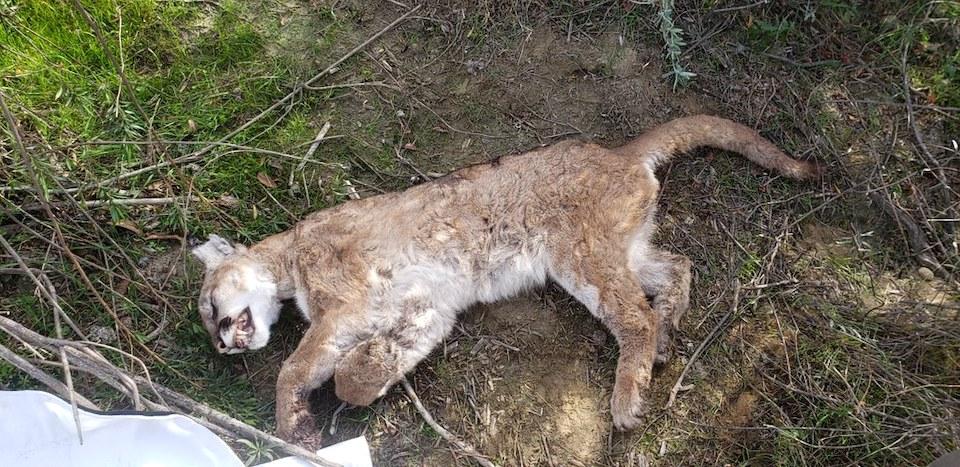
Rat poison was blamed for the death of this mountain lion/NPS
Rat poison is being blamed for the deaths of a mountain lion and bobcat in the Simi Hills and Santa Susana Mountains of California located north of Santa Monica Mountains National Recreation Area.
National Park Service biologists say this marks just the second time in their 24-year study that a bobcat, in this case B-372, has been determined to have died directly from the effects of these poisons, and the first time in 23 years.
P-76, a subadult mountain lion male captured in Northridge late last year and jointly studied by the National Park Service and the California Department of Fish and Wildlife, died of anticoagulant toxicosis in the Santa Susana Mountains.
“We basically never see this in bobcats, so this is an important finding,” said Joanne Moriarty, a Santa Monica Mountains National Recreation Area biologist who has worked on bobcat research for more than 15 years.
According to Moriarty, an examination performed during the bobcat's capture in January determined that she was in good health, and that she had given birth in the past.

Santa Monica Mountains NRA biologists say this bobcat was just the second in 24 years to have been killed by rat poison/NPS
A necropsy report documented brodifacoum, bromadiolone, and diphacinone in the bobcat’s tested liver sample. These compounds include first- and second-generation poisons. Her body was discovered on June 20 under an oak tree in a residential neighborhood of Agoura Hills. She had been captured six months earlier, on January 28, at the south end of Cheeseboro Canyon north of the 101 Freeway.
Although more than 90 percent of bobcats in the NRA's long-running study tested after death have been positive for exposure to one or more AR compounds, the biologists said they do not generally see internal bleeding in bobcats, which is what leads to death directly from AR exposure.
Since 2002, the leading cause of death for bobcats has been disease, specifically notoedric mange, followed by road mortality, according to Moriarty.
Park Service biologists, in collaboration with researchers at UCLA, have found a strong association between the amount of exposure to ARs and fatal mange disease, as well as significant effects of AR exposure on immune function and even gene expression in bobcats.
Researchers have seen coagulopathy (uncontrolled bleeding) leading to death in coyotes, foxes, and mountain lions in the study area, but typically not bobcats.
Generally when biologists have documented coagulopathy due to AR exposure in other species, the animals have appeared otherwise healthy, indicating a potentially large one-time, or short-term, exposure to the ARs sufficient to cause lethal coagulopathy. This was the case for P-76, who appeared to be generally in good health.
In B-372’s case, however, she was extremely emaciated, and a bone marrow test showed signs of chronic anemia, indicating that she may have been experiencing clinical symptoms of coagulopathy over an extended period, which in turn could indicate repeated exposure to AR compounds.
What is also notable about this bobcat is that she spent much of her time in residential areas, according to Moriarty, which is not typical for adult females.
The natural habitat in nearby park areas was devastated by the November 2018 Woolsey Fire, and the biologists documented several other collared bobcats abandoning burned areas in the Simi Hills shortly after the fire. Spending more time in neighborhoods may have led to increased exposure to the poisons often used by homeowners or businesses to control rodents. More exposure, potentially over a shorter time period, could have led to more severe direct impacts of the toxicants than we normally see in this species.
P-76 is the sixth collared mountain lion to die of coagulopathy and the third in the last two years. He was captured and collared by California Department of Fish & Wildlife officers in November 2019 in an urban neighborhood in Northridge, just outside of Los Angeles.
“These two cases show us that different non-target species are continuing to be exposed to these toxicants, including an array of different poisons, with effects up to and including death from uncontrolled bleeding,” said Dr. Seth Riley, the wildlife branch chief and a UCLA adjunct associate professor. “We are also continuing to see lots of cases of severe mange disease in bobcats in the area. Between poisons, disease, and the massive Woolsey Fire, it has been a tough go recently for our wild cats in the park.”
In the case of P-76, his collar went on “mortality mode” the night of January 29, 2020. His carcass was recovered the following morning by NPS and CDFW biologists in the Santa Susana Mountains, north of Highway 118. His body was submitted to the California Animal Health and Food Safety (CAHFS) Lab in San Bernardino for a necropsy and testing, as with B-372. The results, which came back only recently, showed exposure to five compounds (brodifacoum, bromadiolone, chlorophacinone, difethialone, and diphacinone), which include first- and second-generation poisons.
National Park Service researchers have documented the presence of anticoagulant rodenticide compounds in 26 out of 27 local mountain lions that they have tested, including in a three-month-old kitten.
Since 1996, the NPS has been studying carnivores, including bobcats and since 2002 mountain lions, in and around the Santa Monica Mountains to determine how they survive in a fragmented and urbanized environment.
The California Department of Fish and Wildlife is responsible for overseeing the management and conservation of wildlife in the state, including both bobcats and mountain lions.


 Support Essential Coverage of Essential Places
Support Essential Coverage of Essential Places







Add comment